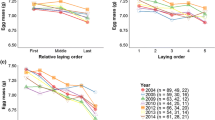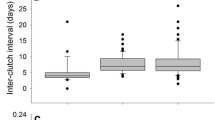Abstract
Whereas in constant environments parental survival has no effect on optimal clutch size in the absence of trade-offs between juvenile and parental survival, the situation is drastically different in fluctuating environments. We consider a model in which, with respect to reproduction, parents and offspring are equivalent at the start of the next breeding season. When generations are non-overlapping, the clutch size maximizing geometric mean surviving number of offspring is optimal among all pure clutch size strategies. We prove that, as parental survival increases relative to that of the offspring, the optimal clutch size converges to the arithmetic mean maximizing clutch size (the so-called ‘Lack clutch size’). We also give a numerical procedure for calculating optimal mixed strategies and we show that, as environmental variance increases and/or parental survival decreases, mixed rather than pure strategies become optimal. Furthermore, we explain how to estimate fitness from empirical data under the assumptions of our model.
Similar content being viewed by others
References
Boyce, M.S. and Perrins, C.M. (1987) Optimizing great tit clutch size in a fluctuating environment. Ecology 68, 142–153.
Bull, J.J. (1987) Evolution of phenotypic variance. Evolution 41, 303–315.
Cavé, A.T. (1968) The breeding of the kestrel, Falco tinnunculus L., in the reclaimed area of Oostelijk Flevoland. Neth. J. Zool. 18, 313–407.
Charnov, E.L. and Krebs, J.R. (1974) On clutch size and fitness. Ibis 116, 217–219.
Cody, M.L. (1966) A general theory of clutch size. Evolution 20, 174–184.
Cohen, D. (1967) Optimizing reproduction in a randomly varying environment when a correlation may exist between the conditions at the time a choice has to be made and the subsequent outcome. J. Theor. Biol. 16, 1–14.
DeSteven, D. (1980) Clutch size, breeding success and parental survival in the tree swallow (Iridoprocne bicolor). Evolution 34, 135–151.
Ellner, S. and Hairston, N.G. Jr. (1994) The role of overlapping generations in maintaining genetic variation in a fluctuating environment. Am. Nat. 143, 403–407.
Forbes, L.S. (1991) Insurance offspring and brood reduction in a variable environment: The costs and benefits of pessimism. Oikos 62, 325–332.
Godfray, H.C.J., Partridge, L. and Harvey, P.H. (1991) Clutch size. Ann. Rev. Ecol. Syst. 22, 409–429.
Goodman, D. (1984) Risk spreading as an adaptive strategy in iteroparous life histories. Theor. Pop. Biol. 25, 1–20.
Haccou, P. and Iwasa, Y. (1995) Optimal mixed strategies in stochastic environments. Theor. Pop. Biol. 47, 212–243.
Högstedt, G. (1980) Evolution of clutch size in birds: Adaptive variation in relation to territory quality. Science 210, 1148–1150.
Högstedt, G. (1981) Should there be a positive or a negative correlation between survival of adults in a bird population and their clutch size? Am. Nat. 118, 568–571.
Iwasa, Y. and Haccou, P. (1994) Emergence patterns of male butterflies in stochastic environments. Evol. Ecol. 8, 503–523.
Johnson, N.L., Kotz, S. and Balakristan, N. (1995) Continuous Univariate Distributions, Vol. 2, 2nd edn. John Wiley, New York.
Klomp, H. (1970) The determination of clutch size in birds: A review. Ardea 58, 1–124.
Kluyver, H.N. (1951) The population ecology of the Great Tit, Parus m. major L. Ardea 39, 1–135.
Konarzewski, M. (1993) The evolution of clutch size and hatching asynchrony in artricial birds: The e.ect of environmental variability, egg failure and predation. Oikos 67, 97–106.
Kubo, T. and Iwasa, Y. (1996) Phenological pattern of tree regeneration in a model for forest species diversity. Theor. Pop. Biol. 49, 90–117.
Lack, D. (1947) The significance of clutch size. Ibis 89, 309–352.
Lack, D. (1966) Population Studies of Birds. Clarendon Press, Oxford.
Liou, L.W., Price, T., Boyce, M.S. and Perrins, C.M. (1993) Fluctuating environments and clutch size evo-lution in great tits. Am. Nat. 141, 507–516.
McGinley, M.A., Temme, D.H. and Geber, M.A. (1987) Parental investment in variable environments: Theoretical and empirical considerations. Am. Nat. 129, 283–303.
McNamara, J.M. (1995) Implicit frequency dependence and kin selection in fluctuating environments. Evol. Ecol. 9, 185–203.
McNamara, J.M. (1997) Optimal life histories for structured populations in fluctuating environments. Theor. Pop. Biol. 51, 94–108.
McNamara, J.M. and Houston, A.I. (1992) State-dependent life-history evolution and its implications for optimal clutch size. Evol. Ecol. 6, 170–185.
McNamara, J.M., Webb, J.N. and Collins, E.J. (1995) Dynamic optimisation in fluctuating environments. Proc. R. Soc. Lond. B 261, 279–284.
Metz, J.A.J., Nisbet, R.M. and Geritz, S.A.H. (1993) How should we define ‘fitness’ for general ecological scenarios? TREE 7, 198–202.
Mountford, M.D. (1973) The significance of clutch size. In The Mathematical Theory of the Dynamics of Biological Populations (M.S. Bartlett and R.W. Hiorns, eds), pp. 315–323. Academic Press, London.
Murray Jr., B.G. (1979) Population Dynamics. Academic Press, New York.
Murray Jr., B.G. and Nolan Jr., V. (1989) The evolution of clutch size. I. An equation for calculating clutch size. Evolution 43, 1699–1705.
Murray Jr., B.G., Fitzpatrick, J.W. and Woolfenden, G.E. (1989) The evolution of clutch size II. A test of the Murray-Nolan equation. Evolution 43, 1706–1711.
Nur, N. (1984a) The consequences of brood size for breeding in blue tits I. Adult survival, weight change and the cost of reproduction. J. Anim. Ecol. 53, 479–496.
Nur, N. (1984b) The consequences of brood size for breeding in blue tits II. Nestling weight, offspring survival and optimal brood size. J. Anim. Ecol. 53, 497–517.
Nur, N. (1988a) The cost of reproduction in birds: An examination of the evidence. Ardea 76, 155–168.
Nur, N. (1988b) The consequences of brood size for breeding in blue tits III. Measuring the cost of repro-duction: Survival, future fecundity, and differential dispersal. Evolution 42, 351–362.
Perrins, C.M. (1965) Population fluctuations and clutch size in the great tit, Parus major, L. J. Anim. Ecol. 34, 601–647.
Perrins, C.M. and Moss, D. (1974) Survival of young great tits in relation to age of female parents. Ibis 116, 220–224.
Perrins, C.M. and Moss, D. (1975) Reproductive rates in the great tit. J. Anim. Ecol. 44, 695–706.
Pettifor, R.A., Perrins, C.M. and McCleery, R.H. (1988) Individual optimization of clutch size in great tits. Nature 336, 160–162.
Philippi, T. and Seger, J. (1989) Hedging one's evolutionary bets, revisited. TREE 4, 41–44.
Price, T. and Liou, L. (1989) Selection on clutch size in birds. Am. Nat. 134, 950–959.
Sasaki, A. and Ellner, S. (1995) The evolutionary stable phenotype distribution in a random environment. Evolution 49, 337–350.
Schaffer, W.M. (1974) Optimal reproductive effort in fluctuating environments. Am. Nat. 108, 783–790.
Schultz, D.L. (1991) Parental investment in temporally varying environments. Evol. Ecol. 5, 415–427.
Seger, J. and Brockmann, H.J. (1987) What is bet-hedging? In Oxford Surveys in Evolutionary Biology, Vol. 4 (P.H. Harvey and L. Partridge, eds), pp. 182–211. Oxford University Press, Oxford.
Slatkin, M. (1974) Hedging one's evolutionary bets. Nature 250, 704–705.
Smith, C.C. and Fretwell, S.D. (1974) The optimal balance between size and number of offspring. Am. Nat. 108, 499–506.
Smith, J.N.M. (1981) Does high fecundity reduce survival in song sparrows? Evolution 35, 1142–1148.
Stearns, S.C. (1976) Life-history tactics: A review of the ideas. Quart. Rev. Biol. 51, 3–47.
Tuljapurkar, S. (1990) Population Dynamics in Variable Environments. Lecture Notes in Biomathematics. Springer-Verlag, Berlin.
Yoshimura, J. and Shields, W.M. (1991) Components of uncertainty in clutch size optimization. Bull. Math. Biol. 54, 445–464.
Author information
Authors and Affiliations
Rights and permissions
About this article
Cite this article
Haccou, P., Mcnamara, J.M. Effects of parental survival on clutch size decisions in fluctuating environments. Evolutionary Ecology 12, 459–475 (1998). https://doi.org/10.1023/A:1006524922128
Issue Date:
DOI: https://doi.org/10.1023/A:1006524922128




